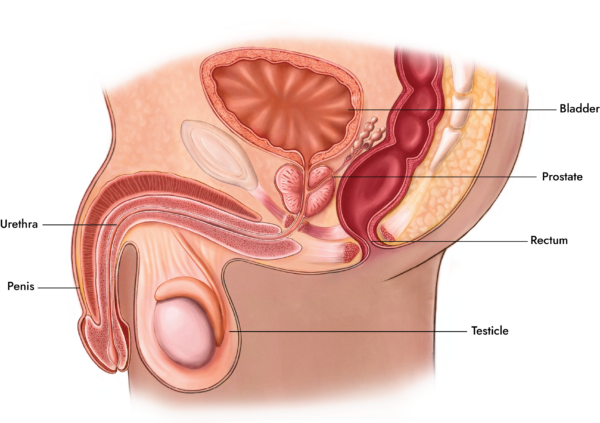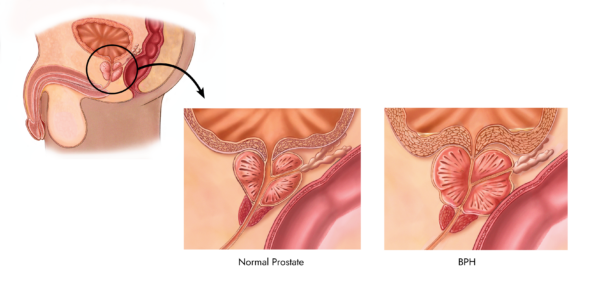Profile of the Prostate Gland
Symptoms of Prostate Problems
Possible Problems of the Prostate
Diagnosis of Prostate Problems
Profile of the Prostate Gland
The prostate is one of the male sex glands – a small but important part of the male reproductive system. Its main job is to produce secretions that make up part of the semen, protecting and enriching the sperm.
A healthy prostate gland is about the size of a walnut and sits just below the bladder, surrounding both the bladder neck and the beginning of the urethra; which is the tube urine passes through.

If you’ve been diagnosed with Prostate Cancer, you can find out more about the disease and how it affects the prostate.
Symptoms of Prostate Problems
Prostate problems become more common as men age. Most of these issues are caused by the benign enlargement of the prostate, but some are caused by cancer.
The symptoms of prostate problems can include:
- Difficulty starting or stopping the flow of urine
- Taking longer to pass urine because the stream is weak, or it stops and starts
- Needing to pass urine urgently, or often, but only passing a small amount
- Getting up during the night to pass urine more than once
- Pain and/or burning when passing urine
- Painful ejaculation
- Blood in the urine or semen
- A dull aching pain in the pelvis
Possible Problems of the Prostate
The symptoms of the most common prostate problems are very similar, but they are treated differently. It’s important to contact your doctor if you find that you are affected by any of the symptoms to find out the root cause, and get appropriate treatment.
Benign Enlargement of the Prostate
In men with prostate problems, nine out of 10 will have an enlarged prostate. Benign enlargement of the prostate, otherwise known as benign prostatic hyperplasia or BPH, is when the prostate increases in size, putting pressure on the urethra and possibly blocking the outflow of urine. BPH commonly occurs with ageing, and affects more than half of all men older than 50. Medicines or surgery are used to treat it but only when symptoms become unmanageable, and it is important to note that while many of the symptoms are similar, BPH is not prostate cancer.

Grace Prostate Cancer Centre urologist Liam Wilson specialises in Laser Prostatectomy for BPH. See his profile here.
Infection of the Prostate
An infection of the prostate (prostatitis) is indicated by pain, fever, swelling of the prostate and blood and pus in the urine. An infection of the prostate is often coupled with an infection of the bladder, and is treated by antibiotics. Again, an infection may have similar symptoms to prostate cancer, and BPH.
Prostate Cancer
Prostate Cancer is the most common form of cancer in New Zealand males, and about 2,500 new cases are diagnosed each year. Prostate cancer may cause pain, difficulty in urinating, problems during sexual intercourse, or erectile dysfunction, but other symptoms can potentially develop during later stages of the disease. Metastasis can also occur – where the cancer has spread to other parts of the body. There are a range of treatment options depending on your situation, the speed and stage of the cancer.
Take a more in-depth look at prostate cancer here, or find out more about the range of treatment options.
Diagnosis of Prostate Problems
The doctor will need to determine whether your problems are due to prostatitis, BPH, prostate cancer or some other cause.
The doctor may do the following tests:
Digital Rectal Exam
The doctor wears a rubber glove and inserts a finger into the anus to feel the prostate through the wall of the rectum. This is called a ‘digital rectal examination’ or DRE. The doctor checks the size, shape and hardness of the prostate.
Prostate Specific Antigen (PSA) Test
PSA is a small protein released into the blood by the prostate. If the amount of PSA in the blood is above normal levels, it may be due to an enlarged prostate, prostatitis or prostate cancer. If the PSA level is high, it is more likely to be due to prostate cancer. However, results from a PSA test alone cannot confirm whether prostate cancer is present. Other tests are necessary.
Biopsy
A biopsy is the removal of very small pieces of prostate tissue using a fine needle. A local anaesthetic may be given first, but most patients say the discomfort is mild. The tissue is then looked at under a microscope to see if cancer cells are present. A biopsy is the only way to see for certain whether or not prostate cancer is present.
There are two types of biopsy:
Trans-rectal biopsy – carried out using local anaesthetic usually in the consultants’ rooms. There may be some discomfort during the procedure.
Perineal prostate biopsy – carried out as a day-stay procedure using a general anaesthetic.
Read more about treatment options available here.

